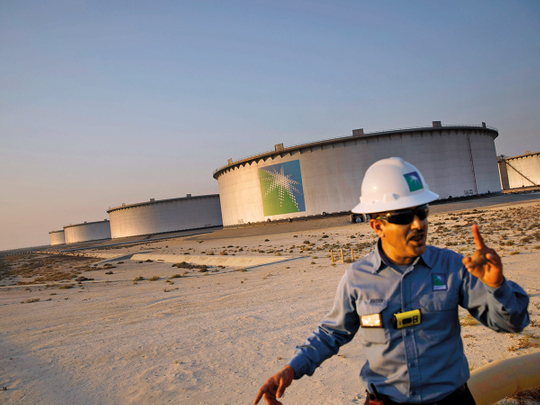
Riyadh (Bloomberg): Saudi Arabians now have the chance to go super-long.
The latest inducement to buy into the IPO of their national oil company is apparently being able to borrow money on a two-for-one basis to buy the shares. Having ditched earlier plans for a big global offering, Saudi Arabia’s biggest earner will now sell stakes mainly to Saudi Arabians using money lent to them by Saudi Arabian banks.
Given Saudi Aramco’s central role in the economy, this is somewhat akin to borrowing money to fill your 401K with your employer’s stock.
Still, an overwhelmingly domestic IPO means that stock competes mostly with domestic benchmarks. And with dividends guaranteed for several years and bonus shares on offer for loyal investors, Aramco screens well on that basis. The mooted price range implies a dividend yield of about 4.4-4.7 per cent, higher than the Tadawul All-Share’s 3.8 per cent, and more than the sub-4 per cent yields of bonds issued by the company and the state.
Flat oil
Aramco’s prospective yield also implies relatively flat oil prices: roughly $60 Brent crude oil. That flat oil price embedded in the valuation range is reassuring in one sense. If oil prices jump for some reason (other than attacks on Aramco’s facilities), then that, combined with the floor provided by the dividend guarantee, could fuel gains.
That $60 oil price, however, is also the flip side of a sanguine view on Aramco’s risks — the lower the discount rate on the cash flows, the lower the oil price required for a given valuation. This is the benefit to Aramco’s current state shareholder of keeping the IPO mostly at home, where the risk profile and range of competing investment options look very different compared to the view in such places as New York, London and Tokyo.
Price setting
A test of this looms almost immediately, in the form of an uncertain outlook for oil balances and prices in 2020. Aramco’s stock is due to price the day of the next Opec meeting, with speculation rife the group may announce even deeper cuts to offset an expected surge in non-Opec supply.
As it is, assuming 11 million barrels a day of crude oil production and $65 oil implies Aramco’s valuation range puts it on a 2020 price/earnings multiple of about 15 to 16 times, toward the top end of its peer group and well above other emerging-market national oil companies. Assume production of 9.5 million a day and $60 oil, and that multiple jumps to 19 to 20 times.
The inducements not to sell may mute the impact of weaker macro conditions next year — which otherwise could be exacerbated by the small float in a small stock market. In avoiding a global IPO, Saudi Arabia obtained the benefit of a higher headline price. That doesn’t mean its citizens are getting Aramco on the cheap, especially if they’re borrowing for the privilege.












